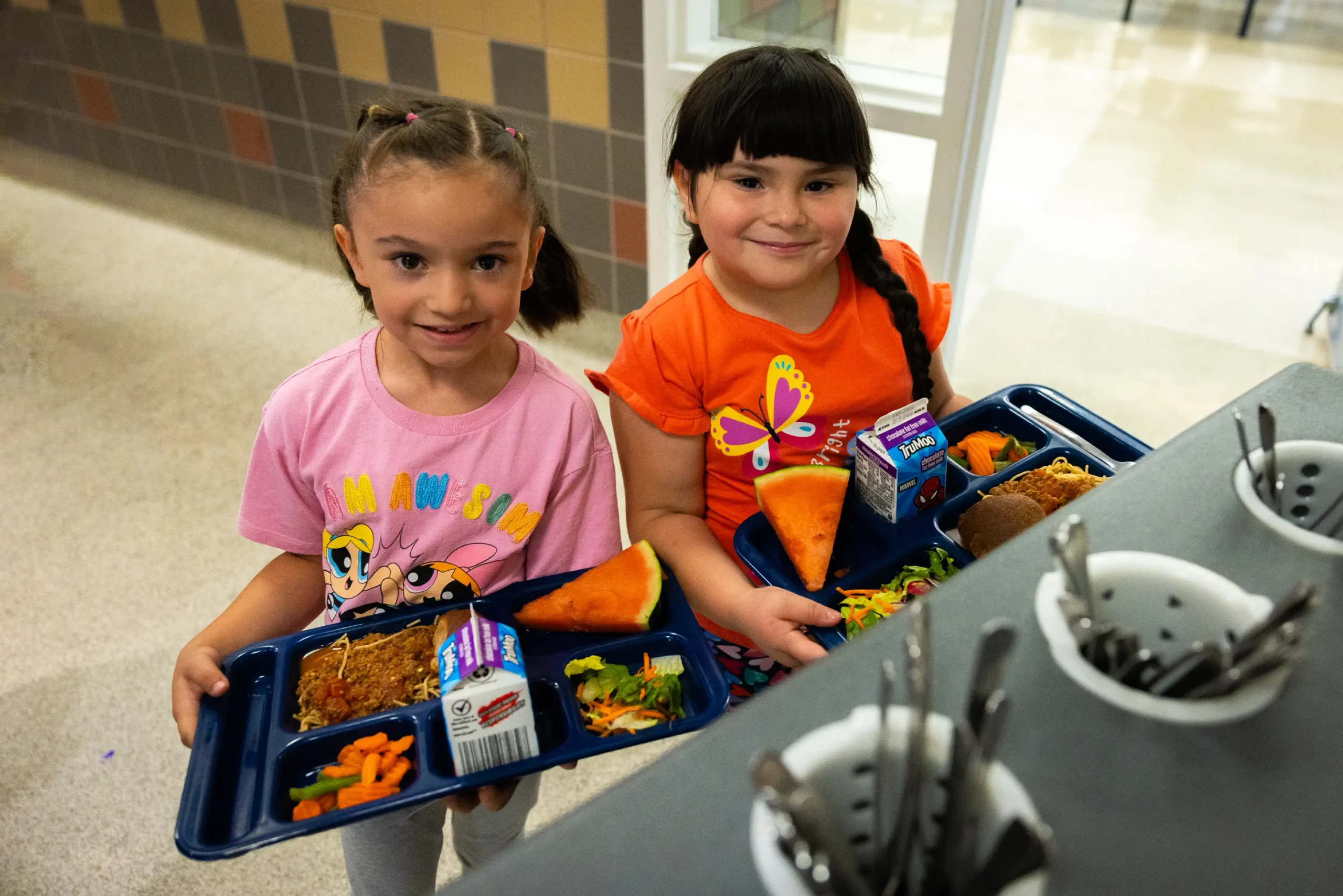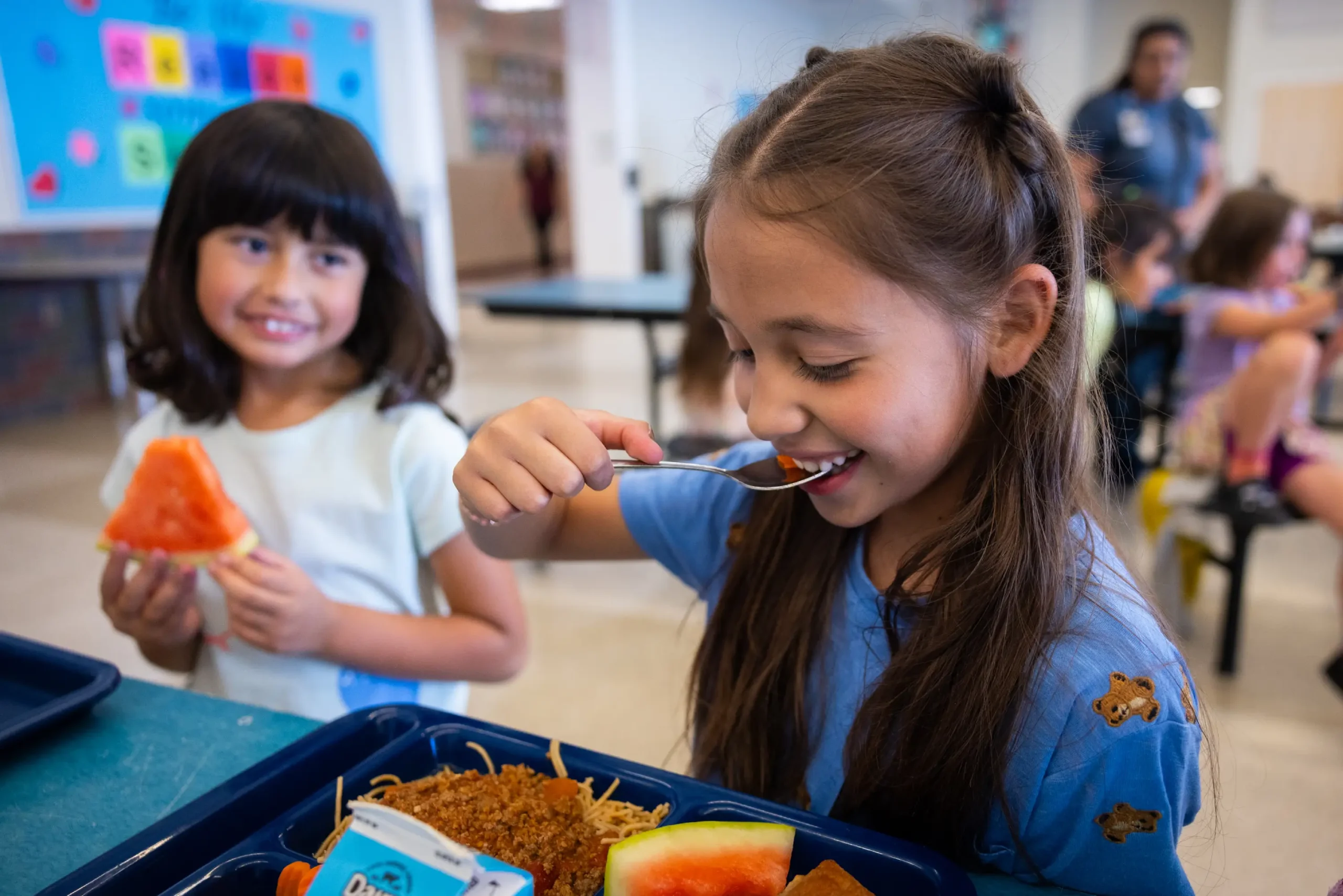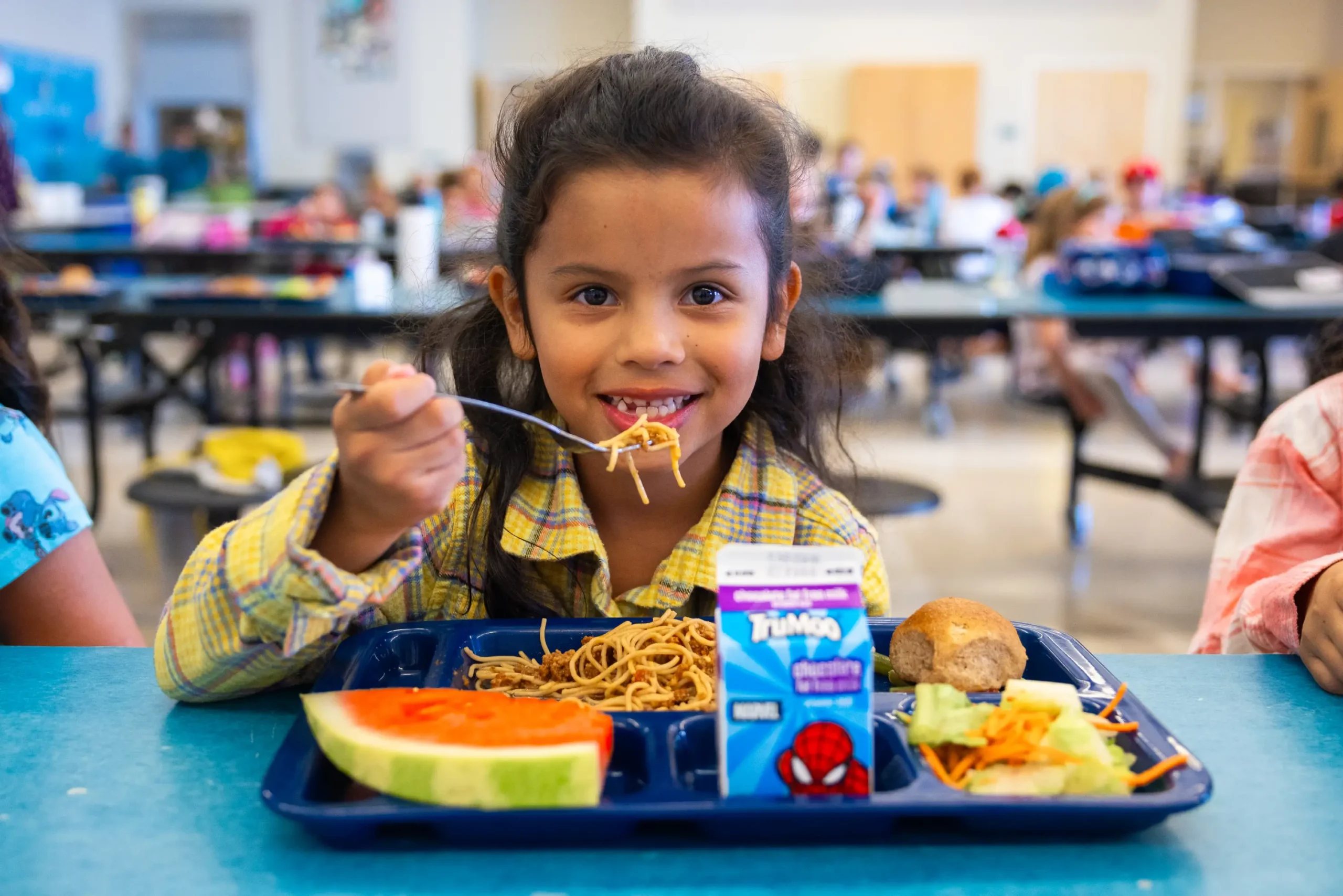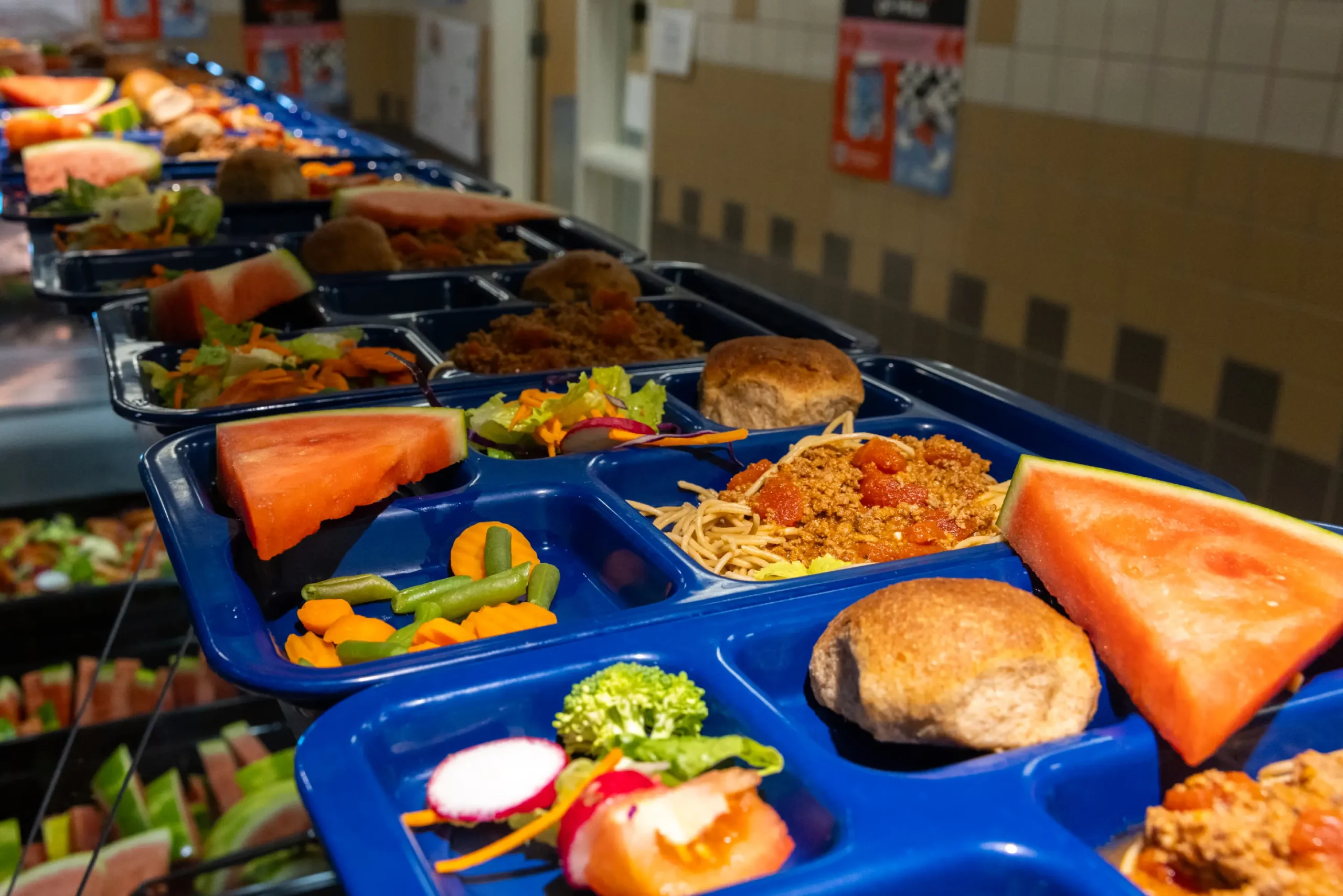A scratch-made school lunch.
New Mexico leads the way in making access to healthy school meals a reality for children
By Dr. Olivia M. Thompson
New Mexico schools have begun preparing for the roll-out of new and improved United States Department of Agriculture (USDA) school nutrition requirements that limit the amount of added sugars and sodium allowed in foods and beverages and increase menu planning flexibilities, particularly for traditional Indigenous foods. Beginning in the 2025-26 school year, the amount of added sugars allowed in breakfast cereals, yogurt, and flavored milk will be reduced; and beginning in the 2027-28 school year, the amount of added sugars allowed across the school week will be limited to less than 10% of total calories. Also beginning in the 2025-26 school year, schools will start gradually reducing the amount of sodium in both lunch and breakfast meals by a total of 15% in lunch meals and 10% in breakfast meals no later than the beginning of the 2027-28 school year.
Currently (as of July 1), schools are able to offer an increased variety of appealing foods for breakfasts, lunches, dinners, and afterschool snacks. For example, schools are able to offer grains, meat or meat alternates (i.e., beans, peas, lentils, cheese, eggs, nuts, seeds, tempeh, tofu, and yogurt), or a combination of both grains and meat or meat alternates to meet nutritional requirements for school breakfasts. Additionally, for breakfasts, schools are able to substitute vegetables for fruits. Now schools can substitute any vegetables for fruits regardless of how many times per week such substitution is made; however, beginning in the 2025-26 school year, if vegetables are substituted for fruits one day per week, schools will be able to offer any type of vegetable and if vegetables are substituted for fruits two or more days per week, schools will be able to offer vegetables from one of four subgroups (i.e., dark green; red/orange; beans, peas, and lentils; and other vegetables).

Children at the end of the lunch line, getting ready to have lunch with their friends.
Schools that are tribally operated, operated by the Bureau of Indian Education, and that serve primarily American Indian or Alaska Native children can substitute vegetables for grains at any meal. Any type of school (tribally controlled or otherwise) can incorporate traditional Indigenous foods into their school meal programs and serve foods in reimbursable school meals. Traditional Indigenous foods are defined by the USDA as “food that has traditionally been prepared and consumed by an Indian tribe” and include wild game meat, fish, seafood, marine animals, plants, and berries. Popular kid-tested recipes such as pinto bean dip with roasted pine nuts, corn chowder with wild plantains and salmon, and bison meatballs with dandelion tomato sauce are available on the USDA’s website (bit.ly/3BLVvVt).
New Mexico is particularly equipped to not only implement the new and improved USDA school nutrition requirements, but is able to go above and beyond. On July 1, 2023, in an effort to dampen New Mexico’s child food insecurity and hunger exigency, Gov. Michelle Lujan Grisham signed Senate Bill 4 (SB 4), which established the Healthy Hunger Free Students Bill of Rights Act. This Act ensures that K-12 students enrolled in operating public and public charter schools (including tribally controlled and private schools that opt in), regardless of their household income, have free-of-cost meals beginning in the 2023-24 school year, with meal quality standards and food waste guidelines being phased in over two years. Meal quality standards include: Ppurchasing New Mexico-produced foods or food products; freshly preparing meals using scratch-cooking methods; providing culturally relevant meals; and engaging students and their families in choices for menu development. Food waste guidelines include: Students in grades K-5 shall be allowed to have up to 20 minutes of seated lunch; and share tables shall be provided whereby allowable food shall be donated to students, food banks, or other nonprofit charitable organizations each school day.
According to Christopher Moya, RDN, a nutritionist with Santa Fe Public Schools, “Santa Fe Public Schools serve several scratch-made meals that comply with SB 4 regulations including spaghetti with meat or marinara sauce with a whole-grain dinner roll and fresh salad loaded with vegetables.”

Children showing excitement for their delicious and nutritious scratch-made school lunch.
Including New Mexico, universal free school meal policies are now permanently adopted in eight states, and studies highlighting policy impacts on child education and health outcomes are extremely positive. Given these impacts, New Mexico has, just this past September, strengthened provisions outlined in SB 4 by adopting a rule that establishes the standards and procedures for SB 4 implementation required for schools to receive an official certification to establish a “healthy universal school meals program” on or before July 1, 2025. Importantly, standards include meal quality improvements for meals to be prepared and cooked for same day consumption using “scratch” or “speed scratch” preparation methods. In other words, meals will be prepared using whole, fresh ingredients that include raw proteins, whole-grains, and fresh fruits and vegetables or made by blending fresh ingredients together with pre-prepared and ready-made, minimally processed ingredients. New Mexico schools will also be eligible to receive incentive grants to purchase New Mexico grown, raised, or processed foods and food products, with a minimum of 75% of funds used to purchase unprocessed and minimally processed products, and with up to 25% of funds used to purchase value-added processed products. By August 1 of each year, certified schools will receive the greater of $1,000 or an amount equal to 10 cents multiplied by the number of lunches qualified for federal free meal reimbursement served to students during the preceding school year.
As Chef Diana M. Tarasiewicz, the current director of nutrition services for Santa Fe Public Schools, discusses, “Santa Fe Public Schools is proactively working toward certification for meal quality improvement, well ahead of the compliance deadline of July 1, 2025, for SB 4. We are conducting a comprehensive review of our recipes to explore opportunities for incorporating more scratch-cooking methods, with a focus on utilizing New Mexico-sourced products, and we are actively applying for grants as one of our biggest challenges in expanding scratch cooking is staffing.”
Furthermore, as Betsy Torres, the former director of nutrition services for Santa Fe Public Schools, adds, “While I have recently retired, I am very proud of the progress made in our schools in providing healthier menu options to children. But there is still a great deal of work to be done. SB4 is a move in the right direction for the health of our children. However, as positive as SB4 may be, adequate funding to support SB 4’s implementation is critical, as is taking a hard look at ways to successfully integrate science-backed nutrition education into K-12 curricula if we truly want to prioritize children’s health and keep it at the forefront.”

Children enjoying their scratch-made school lunch, especially the fresh watermelon.

Child getting ready to take a bite of spaghetti.
Dr. Olivia M. Thompson, PhD, MPH is a nutritional scientist with more than 20 years of public health experience in both private and public sectors. She earned her Masters of Public Health degree in behavioral sciences and health education from Emory University and her doctorate in nutritional sciences from the University of Washington, and she is board certified in public health (CPH). Dr. Thompson currently serves as an associate professor with the University of New Mexico’s College of Population Health, where she teaches public health courses and conducts research designed to improve food systems, reduce food insecurity and hunger, and prevent and control chronic diseases.



